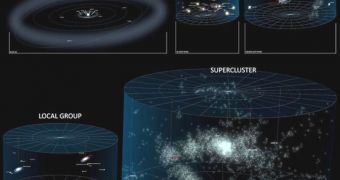The Earth is located in the solar system, that much is certain. In addition to our planet, there are several others orbiting the same star, although their exact number has not yet been established. To most people, the concept of the solar system is the only one standing between our planet and the galaxy. In other words, they do not know the immediate hierarchic order of space structures, from the planetary level to the supercluster. Here are a few markers in this order, as provided by Space Fellowship.
First, a few numbers. The Milky Way is cataloged as a massive spiral galaxy. If features two extensive arms spinning around the core – together, these arms cover an area of about 100,000 light-years across. This is the equivalent distance that the light travels at its constant speed of 100,000 years, or roughly 30,660 parsecs. It is estimated that the galaxy as a whole contains more than 100 billion stars, which may seem like a lot before considering that a single individual's brain has more neurons than that.
Our solar system lies about 25,000 to 28,000 light-years away from the galactic core of the Milky Way, in the Orion Arm. We, as in our Sun and all its planets, are currently navigating through a structure called the Local Interstellar Cloud, or Local Fluff for short, which we entered between 44,000 and 150,000 years ago. It has a temperature roughly equal to that of the Sun, of about 6,000 degrees Celsius. The Earth is also currently “navigating” through what is widely referred to as the galactic habitable zone.
When viewed from further apart, the other arm of the Milky Way, called the Perseus Arm, also becomes visible. This is the galactic level. The galactic realm is the space occupied by our galaxy and all of the other dwarf galaxies that revolve around it. This is a perk that all massive space structures have, of carrying smaller companions around themselves. The same can be said about our neighbor the Andromeda Galaxy, which is located some 2.5 million light-years away and heading straight for us.
When viewed from an even larger distance, the Milky Way and Andromeda reveal themselves as the largest members of what is known as the Local Group, which also contains several dwarf galaxies. Astronomers estimate that about 40 such companions pertain to the giant structure. The Local Group is in turn assigned to the Virgo Supercluster, a massive collection of galaxies, which all revolve around the Virgo Galaxy Cluster, at the center.
Because of its incredible gravitational pull, the Cluster is drawing the Local Group towards it, and there is no way for the Milky Way and Andromeda to escape. Some 100 galaxy groups and clusters are located within the 33 mega-parsec diameter of the Virgo Supercluster. This is one of the millions of observable clusters scattered across the Universe.

 14 DAY TRIAL //
14 DAY TRIAL //